Optimizing Temperature Control During Germination |SeedsHereNow.com
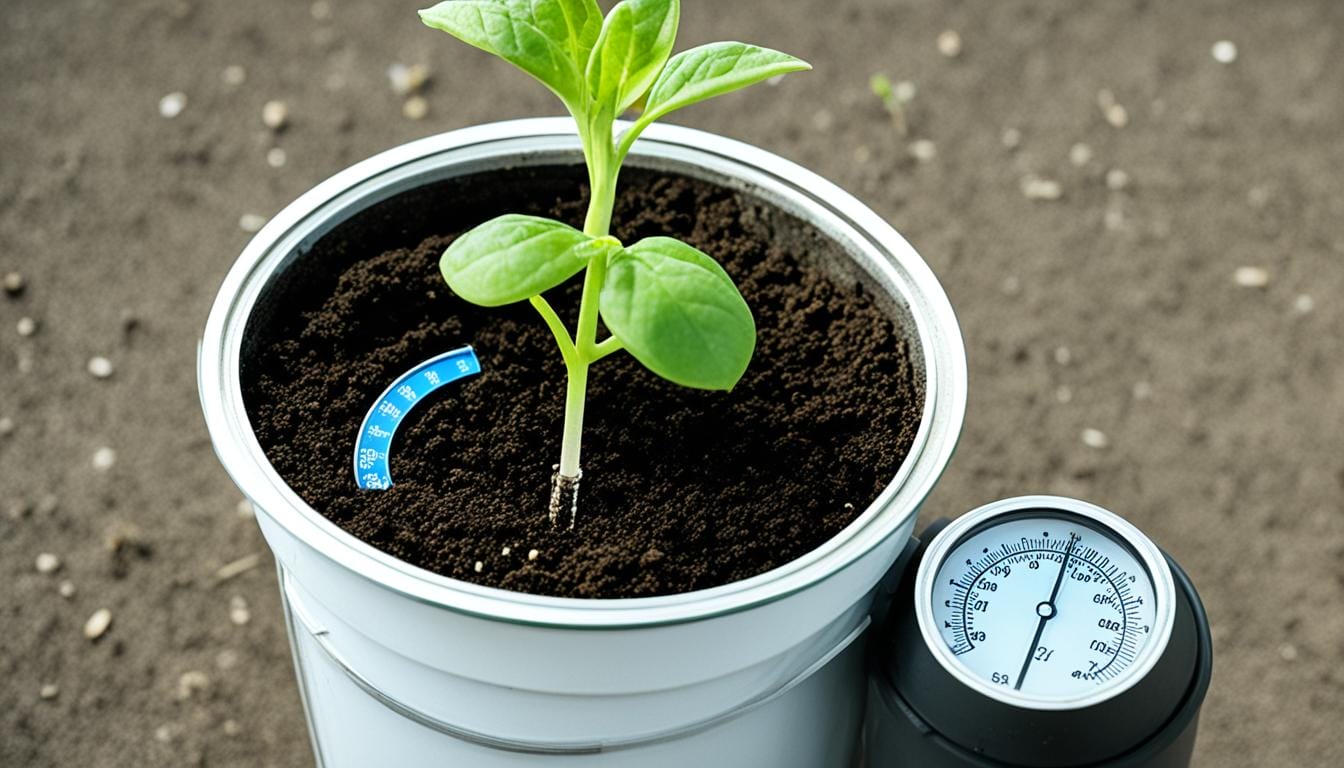
Have you ever wondered why some seeds germinate successfully while others struggle to sprout? It turns out that the secret lies in something as simple as temperature control during germination. The right temperature range can greatly impact the success of seed growth, promoting healthy germination and sturdy seedlings. But what is the ideal temperature for germination? And how can you ensure that your seeds get the temperature they need to thrive?
If you’re eager to unlock the secrets behind temperature control during germination and maximize your seedling development, you’re in the right place. In this article, we will explore the importance of temperature control during germination and how it impacts the success of seed growth. We’ll discuss the ideal temperature range for germination and provide tips on how to achieve optimal results. So let’s dive in and discover the key to unlocking the full potential of your seeds!
Key Takeaways:
- Temperature control during germination is crucial for the successful growth of seeds.
- The ideal temperature range for germination varies depending on the type of seed.
- Controlling temperature fluctuations is important to ensure consistent germination outcomes.
- Monitoring seed viability and adjusting temperature accordingly is essential for optimal seedling development.
- Practical techniques such as using heating mats and monitoring soil temperature can help maintain the proper temperature during germination.
Understanding Seed Germination Temperature
When it comes to successful seed germination, understanding the optimal temperature is key. Different seeds have varying temperature preferences, and providing the right conditions can significantly improve seedling growth. In this section, we will explore the specific temperature requirements for seed germination and how it directly impacts the development of healthy seedlings.
Seeds are remarkably resilient, yet delicate organisms. They require specific temperature ranges to activate their growth and ensure optimal germination. The optimal germination temperature refers to the range at which seeds sprout and seedlings thrive. By providing the right temperature, you can give your seeds the best possible chance to flourish.
Each seed variety has its own preferences when it comes to temperature. Some seeds thrive in warmer temperatures, while others prefer cooler conditions. Understanding the optimal germination temperature range for your specific seeds is crucial for achieving successful germination and promoting healthy seedling growth.
Let’s take a closer look at some common seeds and their temperature preferences:
| Seed Variety | Optimal Germination Temperature Range |
|---|---|
| Lettuce | 55°F – 75°F (13°C – 24°C) |
| Tomatoes | 70°F – 85°F (21°C – 29°C) |
| Carrots | 50°F – 85°F (10°C – 29°C) |
| Peppers | 70°F – 90°F (21°C – 32°C) |
By understanding the optimal germination temperature for each seed variety, you can create the ideal environment for your seeds to thrive. Providing the right temperature promotes seedling growth, helping you achieve healthy and robust plants.
Controlling Germination Temperatures
Ensuring the right temperature conditions during germination is vital for the successful growth of seeds. In this section, we will explore various methods and techniques to effectively control germination temperatures, maximizing your chances of seedling success.
The Importance of Consistent Temperature
Creating a consistent temperature environment is essential for seeds to germinate uniformly. Fluctuations in temperature can negatively impact germination, leading to uneven growth and reduced seedling vigor. By maintaining a stable temperature range, you provide optimal conditions for seeds to thrive.
The Effects of Temperature Fluctuations on Germination
Temperature fluctuations can have significant effects on the germination process. Fluctuating temperatures can disrupt the delicate balance of seed development, resulting in delayed or failed germination. It is crucial to understand and mitigate the adverse effects of temperature fluctuations to promote successful seedling emergence.
Techniques for Controlling Germination Temperatures
There are several techniques you can employ to control germination temperatures and optimize the conditions for successful seedling growth:
- Using a temperature-controlled germination chamber or greenhouse to maintain a consistent temperature range.
- Employing heating mats or cables to provide gentle warmth to the seedbeds and promote germination.
- Utilizing insulation materials to regulate temperature and protect seeds from extreme weather conditions.
- Implementing temperature monitoring systems to ensure accurate control and adjustment of temperature levels.
To dive deeper into these techniques and learn how to effectively apply them in your germination process, refer to the table below:
| Technique | Description |
|---|---|
| Temperature-Controlled Germination Chamber | A controlled environment where temperature and humidity levels can be adjusted to create optimal conditions for seed germination. |
| Heating Mats or Cables | Easily adjustable heating solutions that provide gentle warmth to the seedbed, promoting consistent and faster germination. |
| Insulation Materials | Protective materials that regulate temperature and shield seeds from extreme weather conditions, ensuring a more stable germination environment. |
| Temperature Monitoring Systems | Sensors and devices that continuously monitor the temperature, allowing growers to make precise adjustments and maintain a consistent germination temperature. |
By implementing these techniques, you can establish reliable control over germination temperatures, giving your seeds the best chance to thrive and ensuring successful seedling emergence.
Factors Affecting Germination Temperature
Germination temperature is influenced by various factors that can impact the success of seed growth. Understanding these factors is crucial for creating the optimal temperature environment for seed germination.
“The proper temperature is essential for successful seed germination.”
Heat Tolerance of Different Seed Varieties
Each seed variety has its own heat tolerance level, which refers to the ability of seeds to withstand high temperatures during germination. Some seeds are more heat-tolerant, while others are more sensitive to heat stress.
Heat-tolerant seeds:
- Seeds of tropical plants
- Drought-resistant seeds
Seeds sensitive to heat stress:
- Seeds of cool-season plants
- Seeds adapted to colder climates
Understanding the heat tolerance of different seed varieties is essential for choosing the appropriate temperature range for germination.
Environmental Conditions and Germination
Environmental conditions, such as temperature and humidity, play a significant role in seed germination. Fluctuations in temperature can affect the germination process and impact seedling development.
Temperature requirements for germination:
| Seed Variety | Optimal Germination Temperature Range |
|---|---|
| Tomato | 70-85°F (21-29°C) |
| Pepper | 65-80°F (18-27°C) |
| Lettuce | 40-75°F (5-24°C) |
By understanding the temperature requirements for germination of different seed varieties, growers can create the ideal conditions for successful seedling growth.
Factors affecting germination temperature should be carefully considered to ensure the best possible start for your seeds. By selecting seeds with the appropriate heat tolerance, and providing the right environmental conditions, you can optimize the germination process and maximize the chances of successful seedling development.
Germination Temperature Tips and Techniques
When it comes to successful seed germination, maintaining the optimal temperature is key. In this section, we’ll share practical tips and techniques to help you achieve the perfect temperature for your seeds to thrive.
1. Use Heating Mats
Heating mats are a great tool for providing consistent warmth to your seeds during germination. These mats generate gentle heat that helps create the ideal environment for seedling growth. Simply place the mat under the seed trays or pots and adjust the temperature according to the specific requirements of your seeds.
2. Adjust the Ambient Temperature
In addition to using heating mats, you can also adjust the ambient temperature in the germination area. If the room temperature is too low, consider using a space heater or a heat lamp to raise the overall temperature. Conversely, if the room temperature is too high, you may need to use air conditioning or open windows to cool down the area.
3. Monitor Soil Temperature
It’s essential to keep track of the soil temperature where your seeds are germinating. Use a soil thermometer to measure the temperature and ensure that it remains within the optimal range for germination. Make adjustments as needed by adjusting the position of the seed trays or using insulating materials to regulate the temperature.
4. Provide Adequate Ventilation
Proper ventilation is important during germination to prevent excessive heat build-up and humidity. Ensure that the germination area has good air circulation to avoid any potential issues, such as fungal growth or seedling damping-off. Use fans or open windows to maintain proper airflow.
5. Follow Seed-Specific Temperature Recommendations
Different seeds have varying temperature requirements for germination. It’s crucial to research and understand the optimal germination temperature range for the specific seeds you are planting. Refer to seed packets or reliable online sources for accurate information on temperature requirements.
By implementing these tips and techniques for temperature control during germination, you can maximize the chances of successful seedling growth. Remember to adjust the temperature based on the specific needs of your seeds and regularly monitor the conditions to ensure optimal germination.
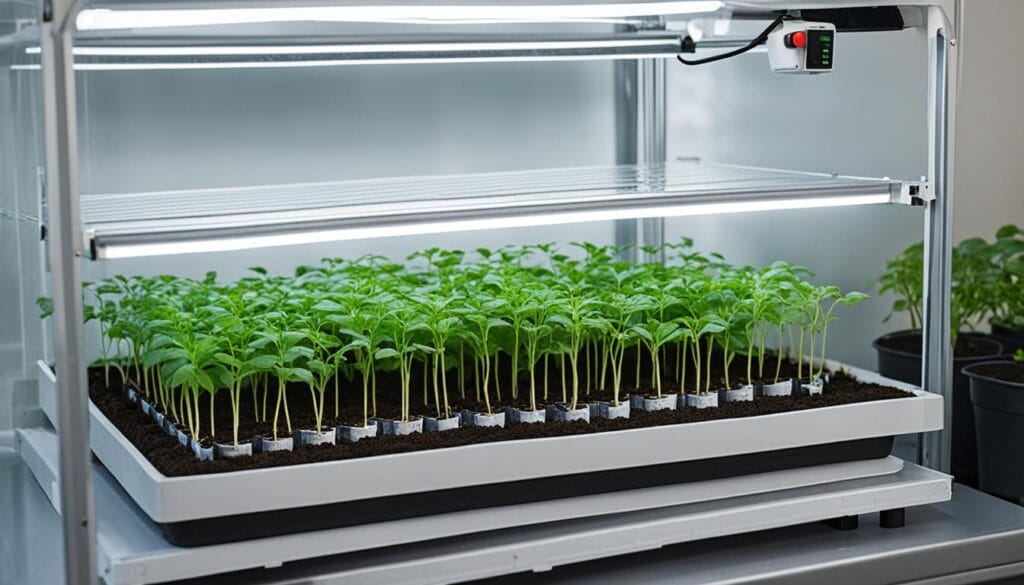
| Temperature Control Tips | Benefits |
|---|---|
| Use heating mats | Provides consistent warmth for seeds |
| Adjust ambient temperature | Creates the ideal growing conditions |
| Monitor soil temperature | Ensures optimal germination conditions |
| Provide adequate ventilation | Prevents heat build-up and humidity issues |
| Follow seed-specific temperature recommendations | Meets the specific needs of different seeds |
Overcoming Temperature Challenges
While temperature control during germination is essential, growers often encounter challenges in maintaining the recommended temperatures. Fluctuating temperatures and extreme weather conditions can pose obstacles to achieving optimal results. However, with the right strategies and techniques, you can overcome these challenges and create a conducive environment for seed germination.
1. Dealing with Fluctuating Temperatures
Fluctuating temperatures can disrupt the germination process and affect seedling growth. To address this challenge, consider implementing the following strategies:
- Use a thermostat-controlled heating system to maintain a consistent temperature.
- Position germination trays away from drafty areas or temperature fluctuations caused by heating or cooling systems.
- Consider using insulation materials, such as germination domes or seedling heat mats, to provide a stable microclimate for the seeds.
2. Coping with Extreme Weather Conditions
Extreme weather conditions, such as heatwaves or cold snaps, can pose challenges for maintaining the optimal germination temperature. Here are some suggestions for coping with extreme weather:
- During hot weather, provide shade or move the germination trays to a cooler spot.
- When facing cold weather, use insulation materials or germination heat mats to keep the temperature within the desired range.
- Consider germinating seeds indoors or in a greenhouse to provide better climate control.
Remember, adapting to temperature challenges requires some experimentation and adjustment. Monitor the temperature closely and make necessary changes to create the best conditions for successful germination.
3. Ensuring Proper Ventilation
Apart from temperature control, ventilation is crucial for creating a healthy germination environment. Proper airflow helps regulate temperature and prevent the buildup of excess moisture, which can lead to fungal diseases. Ensure adequate ventilation by:
- Using oscillating fans to circulate air near the germination trays.
- Opening vents or windows periodically to allow fresh air circulation.
- Avoid overcrowding the germination area, as it can limit airflow.
By addressing temperature challenges and ensuring proper ventilation, you can optimize the germination process and increase the chances of successful seedling growth.
| Temperature Challenge | Solution |
|---|---|
| Fluctuating temperatures | Use thermostat-controlled heating, avoid drafty areas, and consider insulation materials. |
| Extreme weather conditions | Provide shade or move trays, use insulation materials, or germinate indoors. |
| Poor ventilation | Use oscillating fans, open vents or windows, and avoid overcrowding. |
Germination Temperature and Seed Viability
Optimizing temperature control during germination plays a crucial role in ensuring seed viability and promoting successful seedling growth. The right germination temperature can enhance seed quality and increase the chances of healthy germination.
Seeds have specific temperature requirements for germination, and providing the optimal temperature range can significantly impact their viability. Proper temperature control not only affects the germination process but also influences the subsequent growth and development of the seedlings.
“The key to successful germination lies in providing the ideal temperature conditions for the seeds.”
When the temperature is too low, germination may be delayed, and seeds may take longer to sprout. On the other hand, high temperatures can inhibit germination and even lead to seed damage or death. Therefore, maintaining the right germination temperature is crucial for seed viability and successful growth.
In order to optimize temperature control during germination, it is essential to understand the specific temperature requirements of the seeds you are working with. Different seeds have varying temperature preferences, and knowing the ideal germination temperature range for your specific seeds is paramount.
Using a thermometer to monitor the temperature in the germination environment is recommended. This allows you to ensure that the temperature remains within the optimal range for seed germination. Regularly checking and adjusting the temperature as needed will help promote healthy seedling development.
Here are some key temperature guidelines for common garden seeds:
| Seed | Ideal Germination Temperature (°F) |
|---|---|
| Tomatoes | 70-85 |
| Lettuce | 60-70 |
| Carrots | 55-75 |
| Beans | 65-85 |
It’s important to note that these ranges are general guidelines and may vary slightly depending on the specific seed variety. Consulting seed packaging or reputable gardening resources can provide more detailed information on the optimal germination temperature for a particular seed.
By optimizing temperature control during germination and providing the ideal germination temperature range, you can enhance seed viability, promote healthy growth, and increase the chances of successful germination. Remember to monitor the temperature regularly and make necessary adjustments to create the best environment for your seeds to thrive.
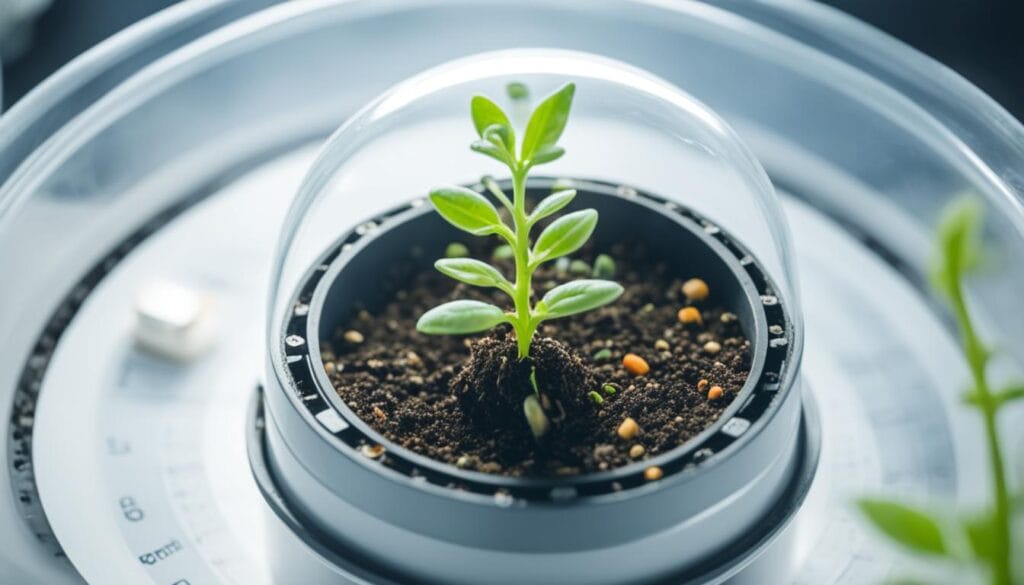
Monitoring and Adjusting Temperature
Monitoring and adjusting temperature during the germination process is essential for ensuring optimal seedling development. By closely monitoring the temperature and making necessary adjustments, you can create the ideal environment for seeds to thrive.
Importance of Temperature Monitoring
Germination temperature directly affects the rate and success of seed germination. It is crucial to maintain the recommended temperature range to provide the necessary conditions for seeds to break dormancy and initiate growth. By closely monitoring the temperature, you can identify any deviations and take timely action to rectify the situation.
Temperature fluctuations can significantly impact seed germination and seedling growth. Fluctuations outside the optimal range can delay or inhibit germination, leading to poor seedling development. Therefore, consistent monitoring is vital to ensure that the temperature remains within the desired range throughout the germination process.
Methods of Temperature Monitoring
There are various methods available for monitoring the temperature during seed germination. Here are a few commonly used techniques:
- Thermometers: Using a reliable thermometer, such as a digital probe or a soil thermometer, allows you to measure the temperature of the germination environment accurately. Place the thermometer in the soil near the seeds to get an accurate reading.
- Automatic temperature controllers: These devices provide precise temperature control by monitoring and adjusting the temperature automatically. They are especially helpful for large-scale germination operations or when maintaining a consistent temperature is challenging.
- Remote monitoring systems: Some advanced systems allow you to monitor the temperature remotely using sensors and data loggers. This enables you to track temperature changes conveniently and make adjustments as needed.
Making Necessary Temperature Adjustments
If you notice that the temperature is outside the optimal range for seed germination, it is crucial to make necessary adjustments promptly. Here are a few tips on how to adjust the temperature:
- Heating or cooling devices: Depending on whether the temperature needs to be increased or decreased, you can use heating mats, heat lamps, or cooling fans to adjust the temperature of the germination environment.
- Insulation: If the temperature is too low, insulating the germination area can help retain heat. This can be achieved by using insulation blankets, reflective materials, or even placing the germination trays in a warmer part of the room.
- Air circulation: Proper air circulation can help regulate temperature and prevent hot or cold spots. Consider using fans or strategically positioning vents to maintain a uniform temperature across the germination area.
Regularly monitoring and making necessary temperature adjustments throughout the germination process will help ensure that your seeds receive the optimal temperature conditions for successful growth.
Now that we have explored the importance of monitoring and adjusting temperature during germination, let’s move on to the final section where we will summarize the key takeaways and provide a conclusion.
Conclusion
In conclusion, temperature control during germination is a vital aspect of successful seed growth. By understanding the optimal germination temperature range and implementing effective techniques to control temperature fluctuations, growers can significantly improve the chances of seedling success. Additionally, monitoring seed viability throughout the germination process ensures that only healthy seeds are nurtured.
When it comes to temperature control during germination, maintaining consistency is key. By providing the ideal temperature conditions for seed germination, growers can create an optimal environment that promotes healthy growth and increases the likelihood of successful germination.
Remember, temperature is just one of the factors that affect seeds’ ability to germinate. Other vital elements such as moisture, light, and proper seed handling techniques should also be considered. By paying attention to these factors and employing the temperature control tips discussed in this article, growers can set their seeds on a path to flourishing into strong and robust plants.
FAQ
Why is temperature control important during germination?
Temperature control is crucial during germination because it directly affects the success of seed growth. Proper temperature conditions help activate enzymes, initiate metabolic processes, and facilitate the absorption of water by the seeds, promoting healthy germination and seedling development.
What is the ideal temperature range for germination?
The ideal temperature range for germination varies depending on the type of seed. However, in general, most seeds germinate well at temperatures between 65 and 85 degrees Fahrenheit (18 to 29 degrees Celsius). It’s essential to research the specific temperature preferences for the seeds you are working with to optimize germination success.
How can I control germination temperatures effectively?
To control germination temperatures effectively, you can use techniques such as using heating mats or cables, adjusting the ambient temperature in your growing area, or providing consistent temperature conditions by using a controlled environment. Monitoring tools like thermometers and temperature controllers can also assist in maintaining the desired temperature range.
Are there any factors that can affect germination temperature?
Yes, there are several factors that can influence germination temperature. Some seeds have specific heat tolerance levels, and extreme temperatures can hinder germination. Environmental conditions, such as humidity and light intensity, can also impact seed germination. It’s important to take these factors into account when creating the optimal germination environment.
What are some tips for maintaining the proper temperature during germination?
To maintain the proper temperature during germination, you can use heating mats or cables to provide consistent warmth, adjust the ambient temperature in your growing area using heaters or air conditioning, and monitor soil temperature using a soil thermometer. It’s also essential to ensure proper ventilation and prevent overheating, which can be harmful to germinating seeds.
How can I overcome temperature challenges during germination?
If you face temperature challenges during germination, there are several solutions you can try. For example, you can insulate your germination area to regulate temperature fluctuations, use grow lights to provide consistent warmth, or create a temperature-controlled space using a greenhouse or grow tent. Adapting your techniques to the specific challenges you face can help you achieve successful germination.
How does temperature control affect seed viability?
Temperature control directly impacts seed viability. Maintaining the optimal germination temperature range enhances the overall health and vigor of seeds, increasing the chances of successful germination. By providing the right conditions, you optimize the germination process, allowing seeds to develop into healthy seedlings with a higher likelihood of long-term success.
Why is monitoring and adjusting temperature important during germination?
Monitoring and adjusting temperature during germination is crucial to ensure optimal seedling development. Regularly monitoring temperature allows you to identify and address any fluctuations that may negatively impact germination. Making necessary adjustments, such as fine-tuning heating or cooling equipment, ensures that seeds receive consistent temperature conditions needed for healthy growth.
Suggested Articles
;)
;)
;)



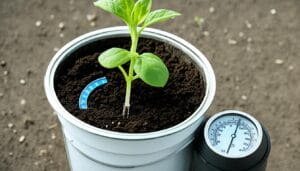
 16 Jun 2025
16 Jun 2025  16 min read
16 min read
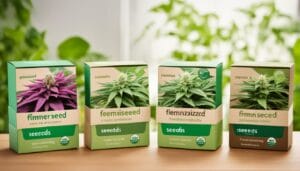
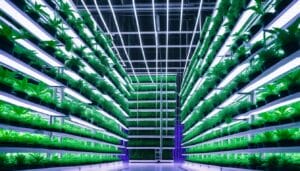
 June 16, 2025
June 16, 2025 


RESPONSES (0)
No responses yet. Be the first to respond!